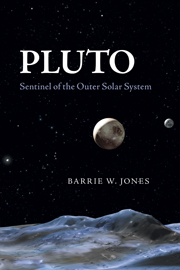Book contents
- Frontmatter
- Contents
- List of tables
- Preface
- Acknowledgements
- 1 The Solar System
- 2 The discovery of Uranus, Neptune and Pluto
- 3 Pluto: a diminishing world
- 4 Pluto's family
- 5 Surfaces, atmospheres and interiors of Pluto and Charon
- 6 The Edgeworth-Kuiper belt
- 7 Is Pluto a planet?
- 8 The New Horizons mission to Pluto (and beyond)
- 9 Pluto: gateway to beyond?
- Glossary
- Further reading and other resources
- Index
3 - Pluto: a diminishing world
Published online by Cambridge University Press: 05 December 2011
- Frontmatter
- Contents
- List of tables
- Preface
- Acknowledgements
- 1 The Solar System
- 2 The discovery of Uranus, Neptune and Pluto
- 3 Pluto: a diminishing world
- 4 Pluto's family
- 5 Surfaces, atmospheres and interiors of Pluto and Charon
- 6 The Edgeworth-Kuiper belt
- 7 Is Pluto a planet?
- 8 The New Horizons mission to Pluto (and beyond)
- 9 Pluto: gateway to beyond?
- Glossary
- Further reading and other resources
- Index
Summary
As soon as Pluto was discovered, astronomers were eager to learn as much as possible about this remote world. What type of body was it that lurked at the outer edge of the Solar System? The most fundamental properties are size and mass. These give the mean density by dividing the mass by the volume; the mean density in turn constrains Pluto's composition.
PLUTO'S SIZE
If Pluto could be seen as a disc then, with its distance known, its size could be estimated from its measured angular diameter, as described in Section 1.6. You might think that with a sufficiently large telescope a disc would have been seen. For telescopes at the Earth's surface this is not the case. There are two reasons for this, given in Box 2.1, reasons that I slightly enlarge upon here.
First, there is the intrinsic limit of the optics (the diffraction limit), the larger the main lens or mirror, and/or the shorter the wavelengths detected, the smaller the fuzzy disc image of a point of light and the better the telescope's resolution. Visible light covers the wavelength range of about 0.38 millionths of a metre (a micrometre), to about 0.75 micrometres. The human eye is most sensitive at about 0.55 micrometres, which we see as green. At this wavelength, a telescope with a perfect main lens or mirror a metre in diameter produces a fuzzy disc such that two points of light separated by about 0.14 arcsec (each imaged as a fuzzy disc), could just be distinguished.
- Type
- Chapter
- Information
- PlutoSentinel of the Outer Solar System, pp. 74 - 92Publisher: Cambridge University PressPrint publication year: 2010



